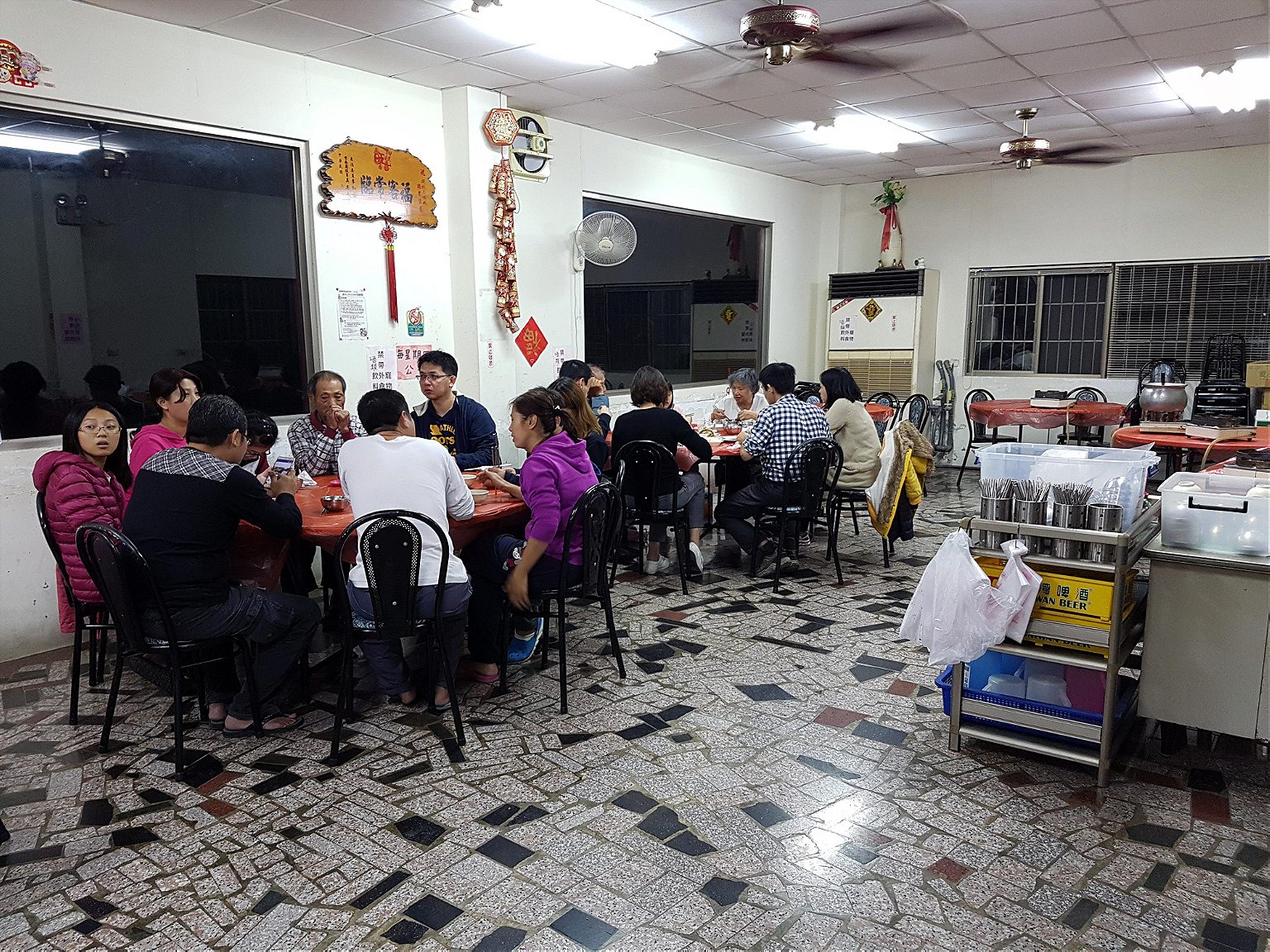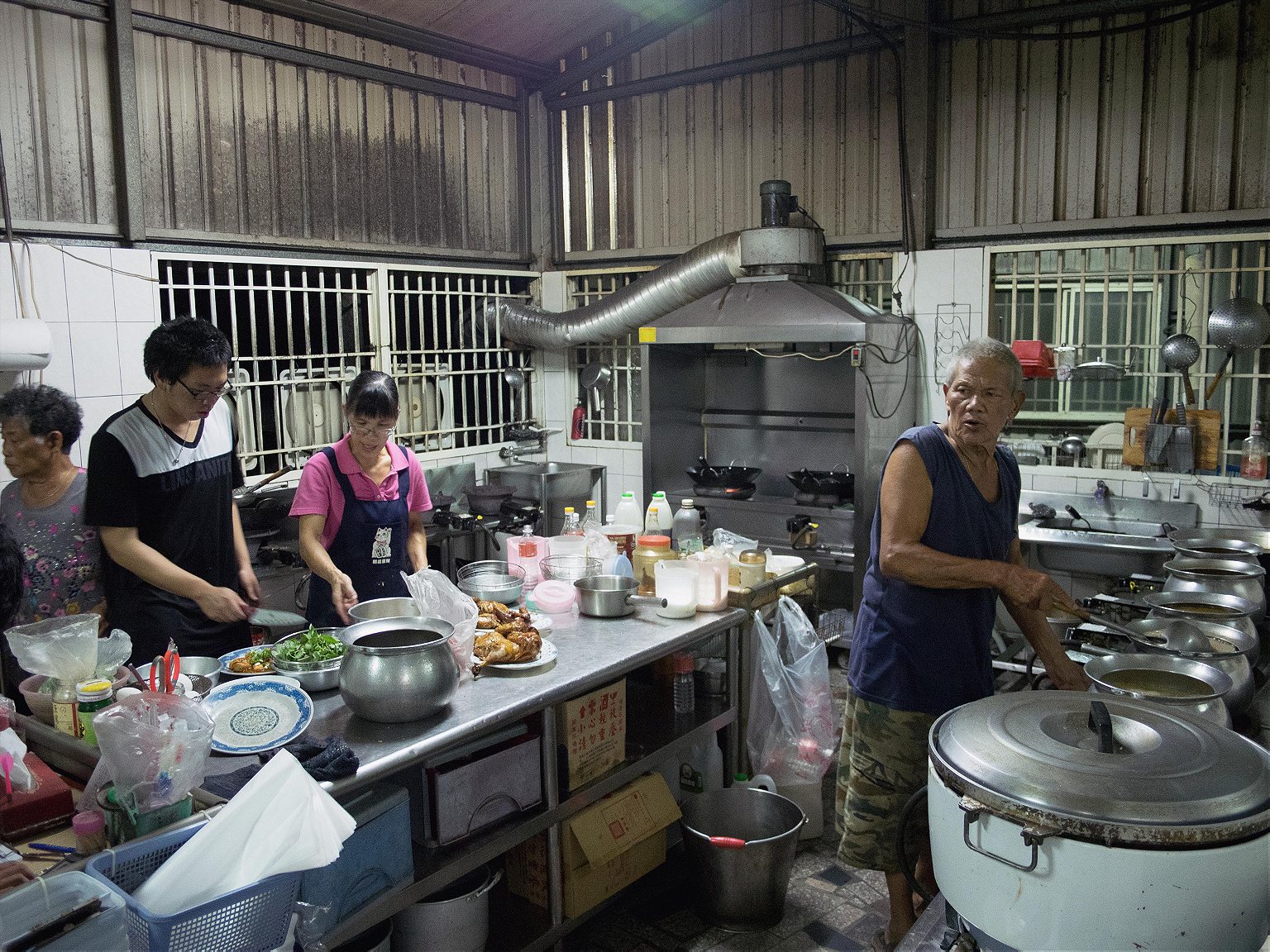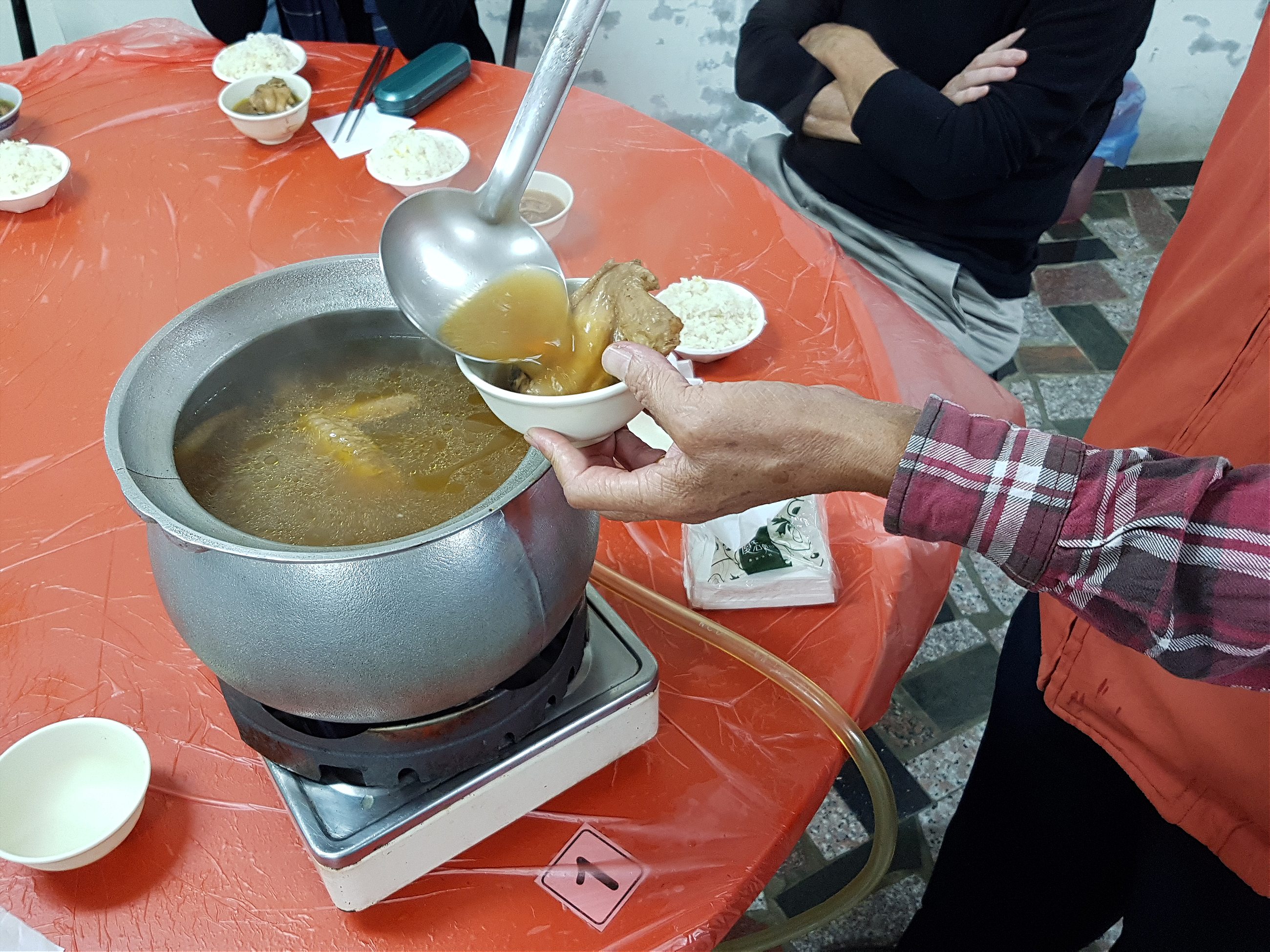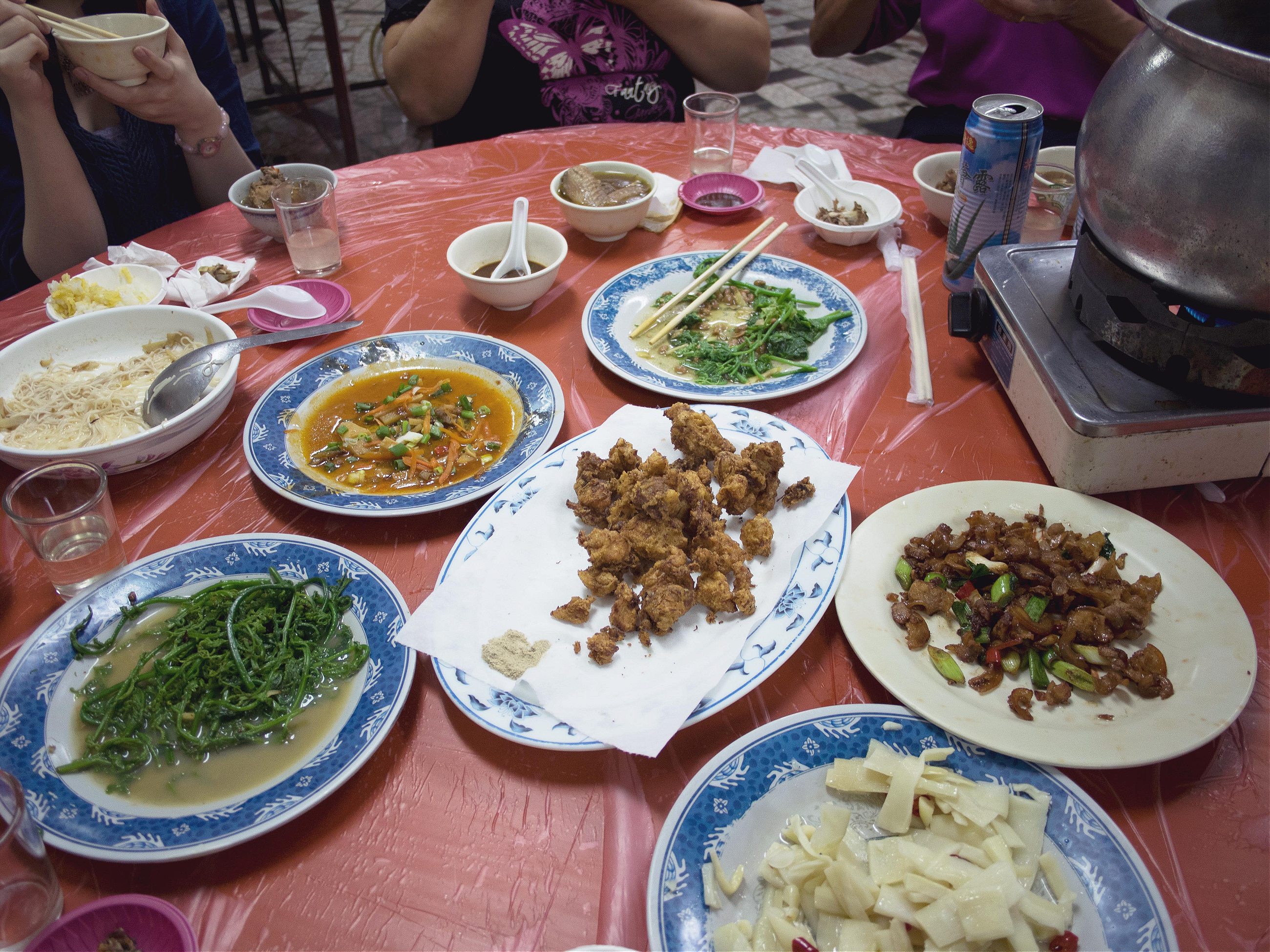These aboriginal restaurants in rural Taiwan are dishing up chicken with a side of identity politics.
TOUSHE, Taiwan—
It’s late October but still balmy enough to have the car windows cracked open a good few inches, and the high-pitched song of the cicadas whirring madly in the dense brush comes drifting in on the breeze. There isn’t enough room in the car, so one of my cousins zips ahead on his scooter, bobbing in and out of our headlights. The nasal whine of the scooter and the earthy-smelling dampness of the evening air are exactly what I remember from when I was growing up in Taiwan, though it’s been nearly two decades since I moved away.
The country road is dark and winding and the terrain unfamiliar. All I know is that my aunt, determined to give her visiting niece a dinner to remember, has called ahead to make sure the tu ji cheng restaurant we’re headed to hasn’t run out of its signature dish. Tu ji cheng literally translates as “earth chicken city,” and I’ve got a screwy spoof of Guns N’ Roses’ “Paradise City” running through my head as the car slows and pull over into a small parking lot. Take me down to earth chicken city, where the grass is green and the poultry pretty…
“We’re here!” my Uncle Yeh announces cheerfully, and we pour out of the car. Here, a glaring beacon of fluorescent light amid a sea of banana and papaya plantations, is our dinner destination. The automatic doors slide open obligingly as we approach the no-frills concrete cube of a restaurant. Inside, extended families are hunkered down in silence, busily ladling and slurping something from cannonball-size cauldrons that bubble away on gas burners in the center of each table. One glimpse says it all: This is going to be good.

It’s chicken that brought us here, a native free-range breed prepared according to a traditional aboriginal recipe. The Pingpu, or Plains Aborigines, my uncle explains, were a diverse group of indigenous people who lived for millennia on the flat river terrain along Taiwan’s western edge. The Danei district where he and my aunt live, a 30-minute drive inland from Tainan city, is the historic homeland of the Siraya tribe. A spry, energetic man with a ready smile, my uncle is one-quarter Pingpu himself and has lived here, in the agricultural heartland of Taiwan, for his whole life.
Though the Plains Aborigines once numbered in the many thousands, it’s long been accepted wisdom that they more or less disappeared, the result of extensive intermarriage with Chinese settlers who came from the mainland between the 17th to 19th centuries. In recent years, however, political and social conditions have led to a resurgence of interest in, and recognition of, the Pingpu. What we’re about to be served for dinner comes with a side dish of identity politics that may have high stakes for the entire country.
As my aunt expertly ticks a flurry of boxes on the order form, I head to the kitchen to see what’s cooking. In a shack out back built simply from aluminum siding, organized chaos reigns. Cleavers thwack rhythmically through chicken carcasses; blackened woks sizzle with hunks of ginger and garlic. A wizened old man with skin gone coppery from the sun dips a bowl into a vat of something bubbling and tastes his handiwork. A nod of approval. The soup is ready.

I head back inside in time to see the teenage server setting up a fresh batch of chicken on our table’s burner. The blue flame licks at the side of the cauldron as my aunt begins ladling out the contents, a Pingpu recipe passed down for generations. The key ingredient is a thorny acacia shrub the aborigines prized for its medicinal properties. First, the stalks and roots are sliced and sun-dried, then steeped in rice wine. A secret blend of medicinal herbs and hunks of bark is added, then simmered steadily for at least four hours over a fire of pomelo tree wood.
Next comes the bird, a descendant of a breed brought over by the Japanese in the 19th century. Though scrawnier than Western varieties, the chickens have a darker-hued meat that the Taiwanese swear is superior in taste and nutrition. A good spell more simmering, and the result is a rich and fortifying broth with a sheen of fat gleaming invitingly on the surface.
I lift the bowl to my lips and drink deeply. Rich and potent, the dark broth has a mildly medicinal flavor, reminiscent of woody ginseng roots and the mysterious dried tidbits that stuff the drawers at a Chinese herbalist’s shop. It tastes, well, healthy, like the kind of thing Chinese grandmothers have been foisting on their ailing offspring for countless generations. I use my chopsticks to fish out a few goji berries and then, finally, the famed chicken itself. Following my cousins’ example, I dip each morsel of meat in a chili-spiked soy sauce. I suck the bones.

More and more dishes keep arriving in quick succession: the pleasantly bitter, curled shoots of the bird’s nest fern, cooked with wee beady-eyed fish and the pickled, caperlike buds of the cordia tree. Sautéed “dragon’s whiskers,” the curly vines of the chayote gourd, served with a wobbly globe of raw egg yolk on top. A steaming tangle of thin wheat noodles bathed in sesame oil. Pinkie-size anchovylike fish that are battered, fried, and popped whole into one’s mouth. Golden-crisp chicken bites, marinated in fermented tofu paste to add a rich, yeasty depth of flavor. Sliced bamboo shoots. Omelette with bits of sun-dried daikon.
This is humble, rustic, country food. Even the rice, cooked with chunks of sweet potato, reflects this: Taiwanese peasants used this trick to make their grain stores stretch further. We help ourselves to aloe juice and bottles of Taiwan Beer from the fridge in the corner. Never mind that we’re making a mess—after we go, the sheet of red plastic covering the table will be gathered up and tossed in the garbage.
The village we’re feasting in, Toushe, is just upriver from where Dutch colonizers set up a trading port in the 1620s. Before the Dutch arrived, Taiwan’s aborigines, Austronesian peoples related to indigenous groups as far away as Polynesia and Madagascar, had lived basically undisturbed since as early as 10,000 B.C. While other tribes on the island were isolated by geography, living high up in the mountains or on the east coast, Plains Aborigines such as the Siraya were exposed to the newcomers, and intermarriage became common. Though the rule of the Dutch was short-lived, labor needs meant they encouraged migration from China.
So by the time the Dutch got the boot a few decades later, Chinese settlers already numbered in the tens of thousands, and they kept coming in droves over the following centuries. The demographics of the island were altered permanently, and it became accepted that Taiwan was the domain of the Han, the ethnic group that comprises more than 90 percent of China.
Even to call Taiwan a country is a political act
Taiwan as we know it today was founded as a breakaway republic by Nationalists from the mainland after they lost the civil war to the Communists in 1949. Though the island has functioned independently since then in every possible sense—politically, socially, economically, militarily—China still claims Taiwan as part of its territory. Their relationship is a delicate dance, with Taiwan seeking to stand up for its own interests without provoking its much bigger next-door neighbor. Even to call Taiwan a country is a political act.
Only over the last decade or so has this mindset begun to shift, putting the Plains Aborigines at the center of questions about Taiwanese identity. The current interest in the Pingpu is indicative of a rise in “Taiwanese ethnic consciousness” and “the advocacy of a Taiwanese history rid of ‘Chinese chauvinism,’ ” sociologist A-chin Hsiau, research fellow at Taipei’s Academia Sinica, wrote in 2000. “The increasing identification with the Plains Aborigines speaks volumes to the ascendancy of the pro-Taiwan view of history.”
Plains Aborigine groups spent years petitioning for official recognition, even appealing to the United Nations. They finally got it last October, when the government of President Tsai Ing-wen, herself a member of the independence-leaning Democratic Progressive Party, amended the Status Act for Indigenous Peoples to include the Pingpu. The culture of the Siraya, the Pingpu subgroup that belongs to this region, is once again alive and well, with temple festivals and sacrifices held throughout the year.
Just how much the Pingpu represent Taiwanese identity depends who you ask. In 2010, a Taipei-based genetics researcher named Marie Lin concluded that up to 85 percent of today’s Taiwanese population could have Pingpu heritage as a result of all those years of intermarriage. Others have disputed this, saying the actual percentage is far lower.
That hasn’t stopped the so-called blood nationalists from seizing upon this as proof of a unique Taiwanese ethnicity distinct from that of China, grounds for ultimately declaring independence. It’s a bold stance that has drawn plenty of criticism. “Pro-independence leaders in Taiwan deliberately redraw ethnic boundaries and rewrite their histories in hopes of generating Taiwanese national consciousness,” Chih-yu Shih, professor of political science at National Taiwan University, wrote in 2004.
My Uncle Yeh, whose mother’s mother was fully Plains Aborigine, is the very embodiment of what blood nationalists would consider quintessentially Taiwanese. He doesn’t need their rationale, however, to back up his pro-sovereignty beliefs. “I am not totally opposed to, nor do I completely identify with the blood nationalists,” he tells me. “My stance is to maintain the way things are. But I believe Taiwan is Taiwan, and China is China. Two governments, two countries.”

It has to be said that relying on bloodline as the basis for defining a national identity is a dangerously slippery slope. And where does someone like me fit into that narrative, a proud Taiwanese with two mainland Chinese grandparents who came in 1949 as part of the Nationalist migration wave, and two British Irish Canadian grandparents on my other side?
I drain the final slurp of soup from my bowl. Every last scraping from the cauldron, broth, precious medicinal roots, and all has been packed up by our server for us to take home. Doggie bag in hand, I head back out into the cool night air.
When I was growing up here in the 80s and 90s, Taiwan was slowly transforming into the fully democratic country it is now. In 1987, the state of martial law imposed by the Nationalist regime in 1949 was finally lifted. In 1996, the first direct presidential election was held. Much has changed in just a couple decades, and with the current climate, it looks like there’s more on the horizon.
We begin the winding drive toward home, the cicadas still singing their same old song in the trees. Some things, at least, will never change.
